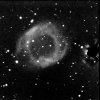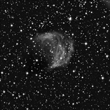 NGC |
 Abell |
 Heinze |
 Other |
From huge rings to tiny discs, planetary nebulae are a joy to observe. Some of them are bright with a high surface brightness that allows them to be observed even under light-ruined skies. Others can be so dim that they challenge the experienced observer with a large telescope.
Planetary nebulae are the death throes of stars similar to the sun. After such a star passes through the red giant stage it ejects its outer layers which form a disc or a ring around the collapsed core of the star. This material shines by absorbing the intense UV light from the central star and re-emitting it as visible light. The gas is slowly expanding and dispersing into the interstellar medium, so planetary nebulae are ephemeral members of the galaxy, with projected lifetimes of around 100,000 years.
When it comes to observing planetary nebulae, there are a number of tricks that will aid in a successful observation. The first is to use appropriate magnification. If the planetary is very large, then use very low magnification, but if it is small, then the magnification can be increased. An OIII filter is an invaluable aid. This is a filter that blocks all light apart from that emitted by doubly ionized oxygen. Planetary nebulae emit light very strongly at this wavelength, so the nebula will not be dimmed when using this filter. However the background sky and stars will be substancially dimmed. Therefore the nebula will stand out much more strongly. If the filter is alterntivly placed in front of the eye and then removed, the planetary will seem to blink in and out of view. For many tiny planetaries, this is the only method of distinguishing the nebula from the stars.
Another trick is to use a dark cover over your head while observing to block any stray light. This helps even in dark country skies.
There are many planetary nebulae that are within reach of a small telescope. As an extreme example, Kent Wallace, a Californian observer who specializes in observing planetary nebulae, has observed over 400 with an 8" schmidt-cassegrain telescope!
 NGC |
 Abell |
 Heinze |
 Other |